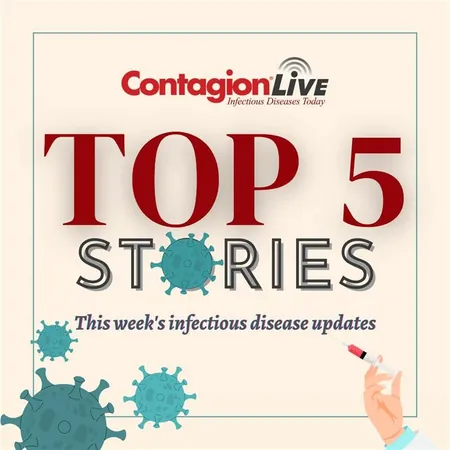
Weekly Roundup: Groundbreaking Developments in Infectious Disease Research (March 29 - April 5)
2025-04-05
Author: Nur
1. Revolutionary Monoclonal Antibody VX-01 Fights Mucormycosis
In an exciting advancement for the treatment of mucormycosis, a deadly fungal infection predominantly afflicting immunocompromised patients, researchers led by Dr. Ashraf S Ibrahim have developed a humanized monoclonal antibody, referred to as VX-01. This innovative treatment operates distinctively compared to conventional antifungal drugs by preventing the fungus from invading blood vessels and tissue, a critical factor in its fatality. Preclinical trials reveal that VX-01 significantly binds to CotH proteins, integral to the fungi's host invasion mechanism. The fusion of VX-01 with existing antifungal therapies has shown to enhance patient outcomes dramatically, and astonishingly, safety assessments have shown no harm to host cells. As mucormycosis cases surge globally due to rising diabetes rates and vulnerable patient populations, VX-01 represents a beacon of hope for better treatment options.
2. WHO Sounds Alarm on Fungal Infection Challenges
The World Health Organization (WHO) has recently highlighted alarming gaps in fungal infection management in two new reports, particularly affecting low- and middle-income countries (LMICs). The reports shed light on the stagnant pipeline for antifungal treatments and diagnostics, which is exacerbated by growing resistance to frontline therapies like fluconazole, notably with pathogens like Candida auris. Although nine antifungals are in clinical trials, few show promise in reaching advanced testing phases. The WHO emphasizes the dire need for rapid, cost-effective fungal diagnostic methods especially in LMICs and advocates for enhanced global surveillance and incentives to promote new antifungal research.
3. Transforming Antimicrobial Therapy with Bayesian Dosing
In a push towards personalized medicine, Bayesian dosing is revolutionizing the management of antimicrobial therapies. As outlined by Sharmeen Roy, PharmD, from DoseMe, this new methodology utilizes advanced pharmacokinetic calculations for tailored drug dosing, crucial for preventing toxicity and optimizing treatment efficacy. Current research shows that while vancomycin remains at the forefront of Bayesian dosing, extending this technology to other antimicrobial drugs, including β-lactams and antifungals, could vastly improve patient care. This systematic approach enhances hospital efficiency and hopes to lower the burden of antimicrobial resistance.
4. LMN-201 Shows 100% C. Difficile Infection Cure Rate in Initial Trials
Lumen Bioscience has unveiled promising data on its investigational oral biologic, LMN-201, which achieved an impressive 100% clinical cure rate in the initial cohort of its RePreve clinical trial for C. difficile infections. Among 21 participants, all displayed clinical resolution, exceeding previous expectations of about 80% seen in larger studies. This biologic targets the C. difficile bacterium and its associated toxins, showing significant potential in preventing infection recurrence—only one patient faced relapse within 28 days. The forthcoming phases of the trial aim to validate the medicine for broader application.
5. New Algorithm for Streamlined Hepatitis C Testing and Treatment
A collaborative effort between the American Association for the Study of Liver Diseases (AASLD) and the Infectious Diseases Society of America (IDSA) has resulted in an innovative "screen and treat" algorithm aimed at reshaping hepatitis C care. This approach simplifies the diagnostic and treatment process into a single patient visit, efficiently reaching high-risk groups often challenged by access to healthcare. Key steps of the algorithm include rapid HCV RNA testing conducted on-site, immediate provision of treatment for those testing positive, and thorough follow-up for confirming viral clearance. Dr. Andrew Aronsohn from the University of Chicago Medical Center emphasizes the importance of this streamlined process in reducing barriers to care and ultimately improving health outcomes for high-risk populations.



 Brasil (PT)
Brasil (PT)
 Canada (EN)
Canada (EN)
 Chile (ES)
Chile (ES)
 Česko (CS)
Česko (CS)
 대한민국 (KO)
대한민국 (KO)
 España (ES)
España (ES)
 France (FR)
France (FR)
 Hong Kong (EN)
Hong Kong (EN)
 Italia (IT)
Italia (IT)
 日本 (JA)
日本 (JA)
 Magyarország (HU)
Magyarország (HU)
 Norge (NO)
Norge (NO)
 Polska (PL)
Polska (PL)
 Schweiz (DE)
Schweiz (DE)
 Singapore (EN)
Singapore (EN)
 Sverige (SV)
Sverige (SV)
 Suomi (FI)
Suomi (FI)
 Türkiye (TR)
Türkiye (TR)
 الإمارات العربية المتحدة (AR)
الإمارات العربية المتحدة (AR)